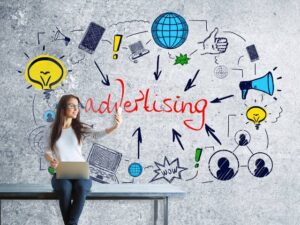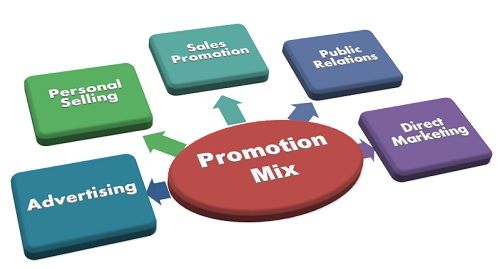The promotion mix is the assortment of communication tools employed by marketing professionals to sell their goods and services. The right promotion mix will depend on the marketing activities that the company has to perform to get its products or services sold.
In this section, five promotional mixes or variables are briefly explained. The elements of the promotion mix are:
- Advertising
- Sales promotion
- Personal selling
- Publicity and public relations
- Packaging.
1. Advertising
Stanton (1983) defines ‘advertising’ as consisting of all the activities involved in presenting a non-personal (oral or visual) openly, sponsored message regarding a product, service, or idea to a group.
Kotler (1984) defines advertising as “any paid form of non-personal presentation and promotion of the idea, goods or services by an identified sponsor”. The message called an advertisement is disseminated through one or more media, and is paid for by an identified sponsor
Forms of Advertising
All advertising may be classified as either product or institutional. In product advertising, advertisers inform or stimulate the market for products or services being sold.
Product advertising is often further subdivided into direct-action and indirect-action advertising. In direct-action advertising, sellers seek quick responses to their adverts.
An advertisement with a coupon may urge the reader to, immediately, order a free sample. Indirect-action advertising is designed to stimulate demand over a longer period; such advertisements are intended to inform customers about the products or service availability and highlight its benefits.

a) Institutional Advertising
Institutional advertising is designed to create a proper attitude toward the seller and to build goodwill; rather than to sell a specific product or service. Institutional advertising is subdivided into three, namely:
i) Patronage- This entails the presentation of information about the advertiser’s business. For example, a retail store advertiser hourly operations or changes in delivery policy as services are offered along with the products being sold.
ii) Public Relations- This provides information about the advertiser’s role in the community. For example, a manufacturer’s ads reveal what the company is doing to reduce the pollution caused by its company-Niger Delta Oil Companies’ case study.
iii) Public Service- This shows the advertiser as a “good citizen”. A company’s ads urge the public to support daytime traveling, rather than night traveling” as encouraged by the Federal Road Safety Corps.
b) National and Local Advertising
i) National Advertising is an advertisement sponsored by manufacturers or other producers. A manufacturer’s advertising is designed to build the demand for its products.
The producers do not care where the goods are purchased, as long as customers buy them.
ii) Local Advertising is placed by retailers. The emphasis is on the stores; retailers do not care about the products or brands bought, as long they are bought in their retail stores.
Thus, the advertisement often features appeals to loyal customers to continually patronize their stores because of certain advantages over other stores within or outside the premises. Examples of these stores include retail stores in our estates and our streets of homes.
Read Also: Basic Importance of Advertising
2. Sales Promotion
Sales promotion is described as “short-term incentives to encourage the purchase or sale of a product or service. The American Marketing Association defines it as:
The marketing activities other than personal selling, advertising, and publicity that stimulate consumer purchasing and dealer effectiveness, such as displays’, shows and expositions, demonstrations and various noncurrent selling efforts not in the ordinary routine”.
Sales promotion mostly serves as a bridge between advertising and personal selling to supplement and coordinate efforts in these two areas. It should be noted that as the number of brands increases, for example, the competitive pressures for display space in retail stores intensify for manufacturers.
These forces increase retailers’ demands for more sales promotional efforts from their suppliers. Sale promotional devices are often the only promotional materials at the point of purchase.
3. Personal Selling
Personal selling is defined as the oral presentation in a conversation with one or more prospective purchasers to make sales.
The goal of all marketing efforts is to increase profitable sales by offering want-satisfaction to the market, over the long run. Personal selling is, by far, the main promotional method used to reach these target goals. Personal selling has the advantage of being flexible in operation as discussed below:
Salespeople can tailor their sales presentations to fit the needs and behavior of individual customers. Also, salesmen can see the customer’s reaction to a particular sales approach and then make the necessary adjustments, immediately.
Personal selling permits a minimum effort. In personal selling, a company has an opportunity to pinpoint its target market far more effectively than with any other promotional desire.
It is personal selling that results in actual sales. Sales men perform many other services that are not strictly selling jobs. They collect information, monitor customers’ attitudes, and relay complaints to the management.
Read Also: Connection Between Marketing and Sales
The main disadvantage of personal selling is that is regarded as very costly. The use of salesmen indeed enables businesses a unit to market with a minimum wasted effort; but, the cost of developing salesmen is high. Besides, personal selling is often limited by a company’s inability to get the right caliber of people needed to do the job.
4. Publicity and Public Relations
Publicity is indirect advertising and it is in the form of propaganda. It is a non-personal stimulation of demand for a product, service, or business unit by a company in a published medium.
Publicity is sometimes regarded as part of public relations. Public relations is described as “building good relations with the company’s various publicity, building up a good corporate image, and handling or heading off unfavorable rumors, stories, and events”. Publicity is mainly informative.
The sponsor does not pay for the media time and space, and thus, has control over when and how the information will be released. It can be in form of news-release, press conferences, letters, etc.
5. Packaging
These days, the packaging is not only regarded as part of the product, but also as a promotional tool. Most products are purchased by consumers, not because of the contents of the products alone, but the packaging is also considered.
Examples are bottled water, such as waterteVGC water, spring water, drugs, ref refrigerators generators, and televisions (Sony, Toshiand LG, etc).
Packaging performs three main functions:
i) It protects the products therein
ii) It provides the convenience of use, storage, and replacement
iii) It promotes a product by communicating its features, uses, benefits, and images to the market.
Read Also: What is Money and Characteristics of Money
